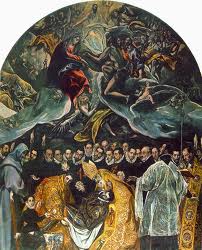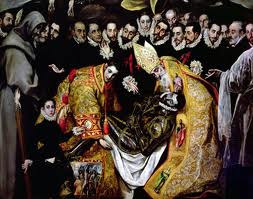El entierro del Conde de Orgaz
'El entierro del Conde de Orgaz' (The Burial of the Count of Orgaz) was painted by the adopted-Spanish painter from Greece, El Greco, in 1588. This painting is considered to be El Greco's best work, and one of the most famous works from the Spanish Mannerist art period.
History

El Greco was commissioned to paint 'El entierro del Conde de Orgaz' by Andrés Núñez, the local Parish priest of the church of Santo Tomé. The painting was to be for the Chapel of the Virgin at the Church of Santo Tomé, El Greco's very own church. El Greco worked on the painting between the years of 1586 and 1588.
The painting instantly became popular and by 1588, people were coming from all over Spain to visit and study the Spanish painting. Its fame was due in part to the depictions of contemporary noble men from Toldeo within the painting itself, as well as its artistic merit. This feature was actually mentioned in the contract for the painting, as it was common for noblemen to attend the burials of other noblemen, and Andrés Núñez wanted the painting to accurately represent real life.
The painting still remains in the same chapel today. Here it has undergone some restoration to try and stop the effects of time. It was first cleaned in 1672 and has been the subject of restoration works in 1943 and 1975.
The Painting
'El entierro del Conde de Orgaz' is a relatively large painting, measuring 4.8 metres by 3.6 metres. The painting is based around the theme of a local legend which originated in the 14th Century. The legend says that Don Gonzalo Ruíz who was a resident of Toledo and a Señor of the town of Orgaz, died in the year of 1312. On his death, the man left a considerable amount of money to the Church of Santo Tomé in order to enable the enlargement of the church. Due to this charitable and noble act, at his funeral, Saint Stephen and Saint Augustine descended from Heaven and buried Don Gonzalo Ruíz with their own hands, in front of the other amazed funeral guests.

The painting is therefore divided into two distinct sections: Heaven and earth. The upper heavenly section is represented with swirling clouds and ethereal, elongated figures. However the lower earthly section is more rational, darkly coloured and the figures are correctly proportioned. The two sections are joined together by the people in the painting as well as the tall torches and crosses carried by the figures.
The notable characters of the upper heavenly section include the Madonna, Saint John the Baptist, and Jesus Christ. Christ is situated at the top of the triangle formed by these three figures. Around the outside of this central focus, there are many apostles and Biblical figures. Strangely, the figure of King Philip II is also included amongst the heavenly figures, even though at the time when El Greco painted 'El entierro del Conde de Orgaz', Philip was still alive.
On earth, Saint Augustine and Saint Stephen, wearing gold and red robes, lean over the armour clad Count of Orgaz. El Greco painted the Count's armour as reflecting the colours of the Saints' clothes. El Greco also included himself and his son, Jorge Manuel, in the painting. The other people that are attending the Count's funeral are other noblemen from Toledo. The expressions of all the figures are extremely powerful and add to the feeling and meaning behind the painting.
The colours of the painting are particularly rich and they are very expressive. The atmosphere of the ceremony is intensified by the juxtaposition of the black mourning suits of the noblemen, with the gold outfits of the two Saints. In Heaven, the greys, blues and whites mix together in order to create a harmony of celestial colours.
